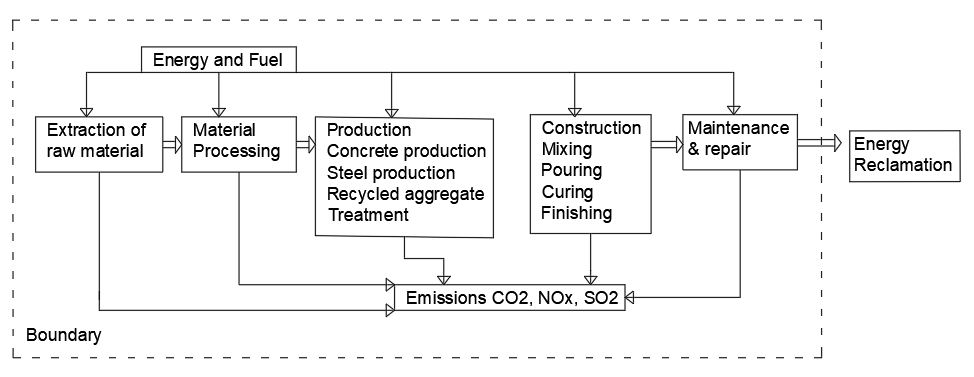Concrete Slab Life Cycle Assessment
➢ SYSTEM:
The concrete slab system consists of a reinforced concrete structure designed for long-term durability and stability. Various alternative concrete mixes are assessed to determine their environmental impact, energy consumption, and material efficiency. The primary focus is on slabs that incorporate recycled and industrial by-products, such as incinerator ash, blast furnace slag, construction and demolition waste, and marble sludge, alongside conventional concrete. These alternatives are evaluated based on their sustainability and long-term performance under structural loads.
➢ SUB-SYSTEM:
For this assessment, the concrete slab is selected as the primary subsystem. It consists of concrete material, reinforcement steel, and insulation layers. Each slab is designed with a consistent geometric profile, ensuring uniformity in comparisons across different material compositions. The system is insulated with either rigid foam or aerogel, which serve as thermal barriers and contribute to overall energy efficiency. The study aims to determine which material combinations minimize carbon footprint and pollutant emissions while maintaining structural integrity.
➢ GOAL AND SCOPE ASSESSMENT:
The primary objective of this assessment is to analyze the carbon footprint, energy consumption, and emissionsassociated with different concrete compositions. Specifically, the study evaluates:
✔ CO₂ emissions from material production and construction processes.
✔ NOx and SO₂ emissions, which contribute to air pollution and environmental degradation.
✔ Total energy consumption over the slab’s 100-year lifespan.
The system boundary includes material extraction, production, construction, and maintenance, but does not account for transportation emissions, which could further influence the results. The best-performing material combination is identified based on its sustainability and environmental impact.
➢ DESIGN OPTIONS:
The following ten design alternatives were considered, each representing a combination of concrete mix type and insulation material:
| Design Option | Concrete Mix | Insulation Type |
| Option 1 | Incinerator Ash (M1) | Rigid Foam (Type1) |
| Option 2 | Blast Furnace Slag (M2) | Aerogel (Type2) |
| Option 3 | Construction & Demolition Waste (M3) | Rigid Foam (Type1) |
| Option 4 | Marble Sludge (M4) | Aerogel (Type2) |
| Option 5 | Ordinary Concrete (M5) | Rigid Foam (Type1) |
| Option 6 | Incinerator Ash (M1) | Aerogel (Type2) |
| Option 7 | Blast Furnace Slag (M2) | Rigid Foam (Type1) |
| Option 8 | Construction & Demolition Waste (M3) | Aerogel (Type2) |
| Option 9 | Marble Sludge (M4) | Rigid Foam (Type1) |
| Option 10 | Ordinary Concrete (M5) | Aerogel (Type2) |
➢ LIFE CYCLE INVENTORY (LCI):
The life cycle inventory quantifies material use, energy consumption, and emissions for each design alternative. The assessment highlights the high energy demand of steel reinforcement, as well as the significant CO₂ emissions of conventional concrete (M5). In contrast, construction and demolition waste-based concrete (M3) demonstrates the lowest environmental impact, making it a favorable alternative.
➢ LIFE-CYCLE TIMELINE:
The concrete slabs undergo a 100-year service life, with periodic maintenance and repair interventions. The timeline for these interventions is consistent across all material choices due to assumed similar durability characteristics.
- Crack Sealing (CS): Conducted at regular intervals to prevent water infiltration and material degradation.
- Strength Repair (SR): Applied when structural performance is affected by environmental exposure.
- Moisture Waterproofing (MW): Necessary to maintain material integrity over the life cycle.
The intervention timeline influences total energy expenditure and emissions, further impacting material selection decisions.
➢ LIFE CYCLE IMPACT ANALYSIS (LCA):
The life cycle impact assessment evaluates the total environmental burden of each design alternative. The findings indicate:
✔ Option 5 and Option 6 (Concrete with Construction & Demolition Waste) perform the best, exhibiting the lowest energy consumption and emissions.
✔ Ordinary concrete (M5) contributes the highest CO₂ emissions, making it the least sustainable choice.
✔ Steel reinforcement is the largest energy consumer, significantly influencing overall environmental impact.
✔ NOx and SO₂ emissions remain similar across all options, reinforcing the need for careful material selection to mitigate pollution.
➢ MULTI-CRITERIA DECISION ANALYSIS (MCDM):
To determine the optimal material choice, an Analytic Hierarchy Process (AHP) was applied, assigning weighted priorities to key environmental factors:
✔ Energy efficiency: Highest priority due to its direct impact on fossil fuel consumption.
✔ CO₂ emissions: Second priority as a primary driver of global warming.
✔ NOx and SO₂ emissions: Equal priority due to their health and environmental effects.
The AHP confirms that Option 5 and Option 6 achieve the best balance between energy efficiency and emissions reduction. However, results could vary based on different project priorities and evaluation criteria.
➢ CONCLUSION:
Based on the findings, concrete made from construction and demolition waste (M3) emerges as the most sustainable alternative, particularly when insulated with either rigid foam or aerogel. The absence of transportation emissions in this analysis suggests that further refinements could provide even greater accuracy in decision-making. This study reinforces the necessity of integrating recycled materials into construction practices, offering a viable pathway toward reducing environmental impact while maintaining structural performance and longevity.












